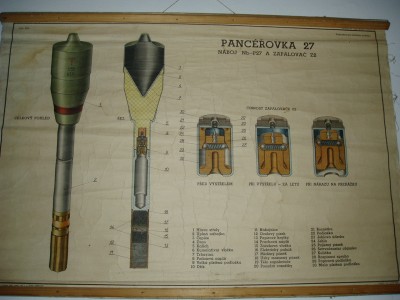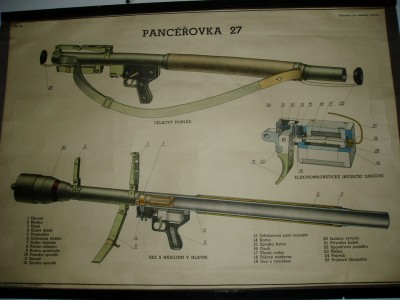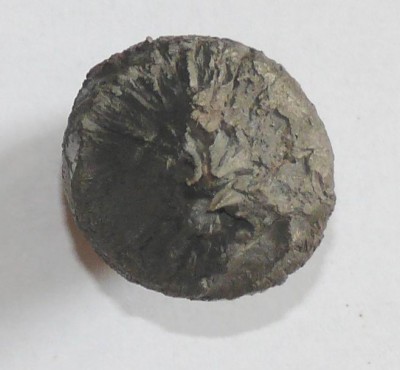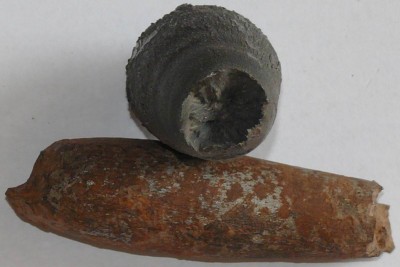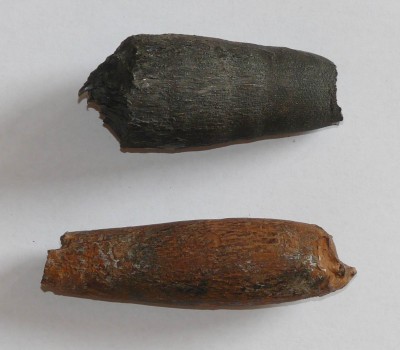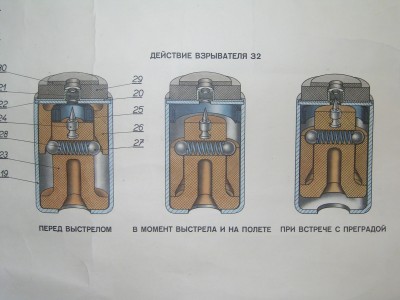Pancéřovka 27 (P27)
Reklama
Panceřovka P 27 was at the time of using the main weapons of the shooting team. Its crew consisted of a shooter and a cartridge carrier. In the extreme case, the weapon could be operated by one man. The weapon was without recoil. To expel the projectile from the barrel used the reactive effect of the flue gas, the pressure of which was compensated in the barrel by a backward moving piston made of steel sand, which fired along with the flue gas and fragments of a crushed cartridge threatened the space behind the weapon. The endangered area was 40 m and at an angle of 60 degrees behind the weapon. When firing from a trench or trench, the end of the weapon had to be at least 1 m away from the rear wall. The missile was stabilized in flight by a vertical front surface with a sharp peripheral edge.
Combat rate of fire - 6 rounds per minute,
weapon weight - 6.4 kg,
weight of stretcher for hub - 1,075 kg
Visible distances: 50, 75, 100, 125, 150 m
The weapon was designed
up to 50 m - for the destruction of crews, timber defensive structures, fortified buildings and tanks in a tower position
up to 75 m - to destroy tanks and armored vehicles of all kinds as moving targets
up to 100 m - to destroy tanks and armored vehicles of all kinds as fixed targets
up to 150 m, the weapon could exceptionally be used against live targets, especially when repelling runoff.
It was approved for armament in 1949 and in 1951 serial production began.
Combat rate of fire - 6 rounds per minute,
weapon weight - 6.4 kg,
weight of stretcher for hub - 1,075 kg
Visible distances: 50, 75, 100, 125, 150 m
The weapon was designed
up to 50 m - for the destruction of crews, timber defensive structures, fortified buildings and tanks in a tower position
up to 75 m - to destroy tanks and armored vehicles of all kinds as moving targets
up to 100 m - to destroy tanks and armored vehicles of all kinds as fixed targets
up to 150 m, the weapon could exceptionally be used against live targets, especially when repelling runoff.
It was approved for armament in 1949 and in 1951 serial production began.
I think that the description "To expel the projectile from the barrel used the reactive effect of the flue gas" is quite unfortunate, in reality it is not a reactive weapon, because the propellant does not burn after a trip from the barrel. The projectile charge burns in the barrel and expels the caliber projectile, the recoil of the weapon is then balanced by a second charge which in the opposite direction sweeps the compensating mass (here metal dust) just because it is not a reactive weapon, the shooter does not have to wear any protective equipment. . This was necessary for the first models of reactive weapons (such as panzerschreck) as protection against flue gases from a reactive missile. The weapon did not lack recoil, but was really tolerable for the size of the projectile.
Minor specification: P-27 is a recoilless weapon. The momentum of the projectile and its effect on the weapon is compensated by the momentum of the counterweight made of metal sawdust, which moves in the opposite direction. The counterweight has less weight, but significantly higher speed. The projectile cartridge (number 14 in figure vz27 (1)) is actually one with the igniter in the middle, not two, although this is what the drawing looks like.
In the picture (vz27) it is good to see how long the path of the counterweight in the weapon is in comparison with the path of the projectile (or its bottom, which is affected by the gas pressure during the shot).
In the picture (vz27) it is good to see how long the path of the counterweight in the weapon is in comparison with the path of the projectile (or its bottom, which is affected by the gas pressure during the shot).
Reklama
The remainder after the explosion of the cumulative charge of the P-27 armor, the so-called thickness
"dark" was dug out of the ground right after the shooting, still hot, has a length of about 6 cm, rusty is 7 cm long and lay in the ground for a long time (it is not quite certain that it comes from the P-27, various ammunition was torn at the site) .
Note the typical structure of the surface of the hammer and its "frayed" end. The corrugation of the surface, together with the different surface structure, suggests that the explosion was not quite ideal, either the detonation velocity of the charge (or rather the detonation pressure) fluctuated, or the resistance of the liner to deformation changed - either due to its variable structure or variable thickness.
The second image shows a cavity at the point where the cumulative beam erupted during the explosion. Some of the material could separate later, due to the enormous internal stress.
"dark" was dug out of the ground right after the shooting, still hot, has a length of about 6 cm, rusty is 7 cm long and lay in the ground for a long time (it is not quite certain that it comes from the P-27, various ammunition was torn at the site) .
Note the typical structure of the surface of the hammer and its "frayed" end. The corrugation of the surface, together with the different surface structure, suggests that the explosion was not quite ideal, either the detonation velocity of the charge (or rather the detonation pressure) fluctuated, or the resistance of the liner to deformation changed - either due to its variable structure or variable thickness.
The second image shows a cavity at the point where the cumulative beam erupted during the explosion. Some of the material could separate later, due to the enormous internal stress.
Well, if I remember correctly (it's been a long time since I've worked this out), the propellant charge consists of two parts between which is inserted an electric igniter (which ignites, of course, both parts that are attached to each other) take, of course, one common driving charge. Due to the difference in weights, it is obvious that both masses move at different speeds and therefore the "barrel" is backwards much longer, so that both masses (ie bullet and counterweight) leave the weapon at about the same time. This ensures maximum use of combustion gases to propel the charge, the counterweight will fall apart and fly behind the weapon (therefore it must not stand behind it). Because it is not possible to balance the forces exactly for various reasons (the temperature is said to be involved), the weapon has a certain recoil, but it is smaller than when firing, for example from a submachine gun (at least that's how I would describe it)
source: own memories of the time of my VZS
source: own memories of the time of my VZS
Pancierovka 27 is designed to fight tanks and armored vehicles of all kinds. It can also be used to fire logs and to destroy manpower.
Pancierovka 27 is a simple weapon without recoil.
The charge is fired by an electric current generated in the electromagnetic induction device of the trigger.
Gases generated during firing endanger the space behind the weapon up to a distance of 40 m in a conical space with an apex angle of 60 °.
Shooting measures:
- the shooter must be in such a position that in no case does he approach the buttocks with his body or equipment, especially in the rapidly expanding gases,
- the shooter's body should be perpendicular to the weapon, when shooting lying down, it should form an angle of at least 45 ° with it,
- when shooting and training with armor, it is inadmissible for people behind the weapon to a distance of 40 m, ammunition, combustibles, etc.
Ammunition:
- ammunition for armor 27 - Nb-P27 - incendiary charge,
- training cartridge - Nb-Cv-P27.
Main parts of the weapon:
- full barrel,
- sights,
- trigger,
- full touch
- bipod.
Main technical data:
Caliber: 45 mm
Initial firing speed: 71.5 m/s
Combat rate of fire: 6 rounds/min.
Effect at the target: reloaded all known tank armor (at the time of deployment - note from the author of the article).
Effective range in m:
- for fixed targets up to: 100,
- for moving targets up to: 75,
- for live targets up to 150.
Max. range: 360 m
Dimensions in mm:
Length: 1030
Weight in kg:
Armor: 6.4
Charge: 3.75
Shots: 3,
Explosives: 1.3
Accessories: 11.65
Service: 2 men
- shooter: in addition to the weapon and the shooter's bag, carries 2 stretchers with ammunition,
- ammunition carrier: carries 4 ammunition carriers.
Source: Del-21-2, regulation ČSĽA Prague 1957
Pancierovka 27 is a simple weapon without recoil.
The charge is fired by an electric current generated in the electromagnetic induction device of the trigger.
Gases generated during firing endanger the space behind the weapon up to a distance of 40 m in a conical space with an apex angle of 60 °.
Shooting measures:
- the shooter must be in such a position that in no case does he approach the buttocks with his body or equipment, especially in the rapidly expanding gases,
- the shooter's body should be perpendicular to the weapon, when shooting lying down, it should form an angle of at least 45 ° with it,
- when shooting and training with armor, it is inadmissible for people behind the weapon to a distance of 40 m, ammunition, combustibles, etc.
Ammunition:
- ammunition for armor 27 - Nb-P27 - incendiary charge,
- training cartridge - Nb-Cv-P27.
Main parts of the weapon:
- full barrel,
- sights,
- trigger,
- full touch
- bipod.
Main technical data:
Caliber: 45 mm
Initial firing speed: 71.5 m/s
Combat rate of fire: 6 rounds/min.
Effect at the target: reloaded all known tank armor (at the time of deployment - note from the author of the article).
Effective range in m:
- for fixed targets up to: 100,
- for moving targets up to: 75,
- for live targets up to 150.
Max. range: 360 m
Dimensions in mm:
Length: 1030
Weight in kg:
Armor: 6.4
Charge: 3.75
Shots: 3,
Explosives: 1.3
Accessories: 11.65
Service: 2 men
- shooter: in addition to the weapon and the shooter's bag, carries 2 stretchers with ammunition,
- ammunition carrier: carries 4 ammunition carriers.
Source: Del-21-2, regulation ČSĽA Prague 1957
Pancéřovka 27 and Wojsko Polskie
The first hundred pieces of these pancéřovek Poland received 30. December 1952 together with 10 000 bullets. These were intended mainly for testing. The poles wanted this pancéřovku licensed to produce, but the price of 1200 rubles per piece they seemed high, so she tried to reduce to 800 rubles, which was not of our party accepted. Since this type of weapon Poles in the arsenal of your army do not, followed by another order on the P-27 and ammo though this gun has a number of defects, and thus is thinking about its modernisation in Poland, however, which means additional financial costs.
In 1954 he offered the Soviet union licensed production of rpgs RPG-,2 and therefore, the Polish people's army ceased to have a P-27 for more interest. In June 1955 they removed the Poles the last of the
1500 in 1953, the ordered P-27 and 10 000 rounds of ammunition. A total of the Polish people's army has received 2 600 pancéřovek P-27 and 84 940 rounds of ammo. Rpgs were from the equipment discarded in the mid 60's. years and later sold to the allies of the socialist block, so thoroughly, that in the whole of Poland remained to this day only two pieces. Almost also there are pictures of the training with this weapon.
The first hundred pieces of these pancéřovek Poland received 30. December 1952 together with 10 000 bullets. These were intended mainly for testing. The poles wanted this pancéřovku licensed to produce, but the price of 1200 rubles per piece they seemed high, so she tried to reduce to 800 rubles, which was not of our party accepted. Since this type of weapon Poles in the arsenal of your army do not, followed by another order on the P-27 and ammo though this gun has a number of defects, and thus is thinking about its modernisation in Poland, however, which means additional financial costs.
In 1954 he offered the Soviet union licensed production of rpgs RPG-,2 and therefore, the Polish people's army ceased to have a P-27 for more interest. In June 1955 they removed the Poles the last of the
1500 in 1953, the ordered P-27 and 10 000 rounds of ammunition. A total of the Polish people's army has received 2 600 pancéřovek P-27 and 84 940 rounds of ammo. Rpgs were from the equipment discarded in the mid 60's. years and later sold to the allies of the socialist block, so thoroughly, that in the whole of Poland remained to this day only two pieces. Almost also there are pictures of the training with this weapon.
Author: Ivan Banged
.Diskuse
Well that's nice, I had a chance to buy one today for 12k but it was scuffed and just plain junk. Well, the question is whether the RPG-7 or the still armoured P27 has been put into the armoury at all during the reactivation of the fortifications. Same with the T21 Tarasnica, I'm looking for that one too by the way.
Join us
We believe that there are people with different interests and experiences who could contribute their knowledge and ideas. If you love military history and have experience in historical research, writing articles, editing text, moderating, creating images, graphics or videos, or simply have a desire to contribute to our unique system, you can join us and help us create content that will be interesting and beneficial to other readers.
Find out more
